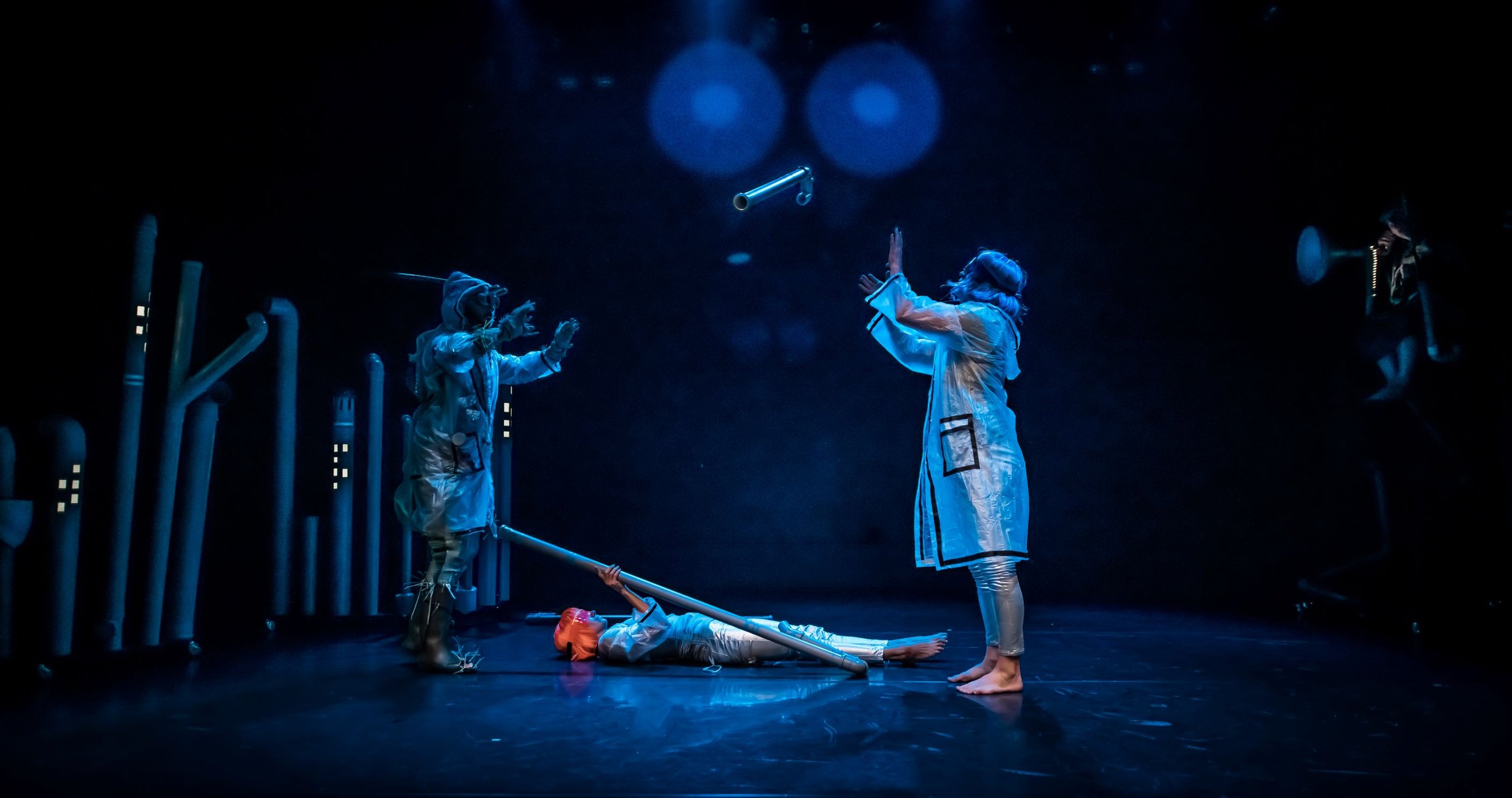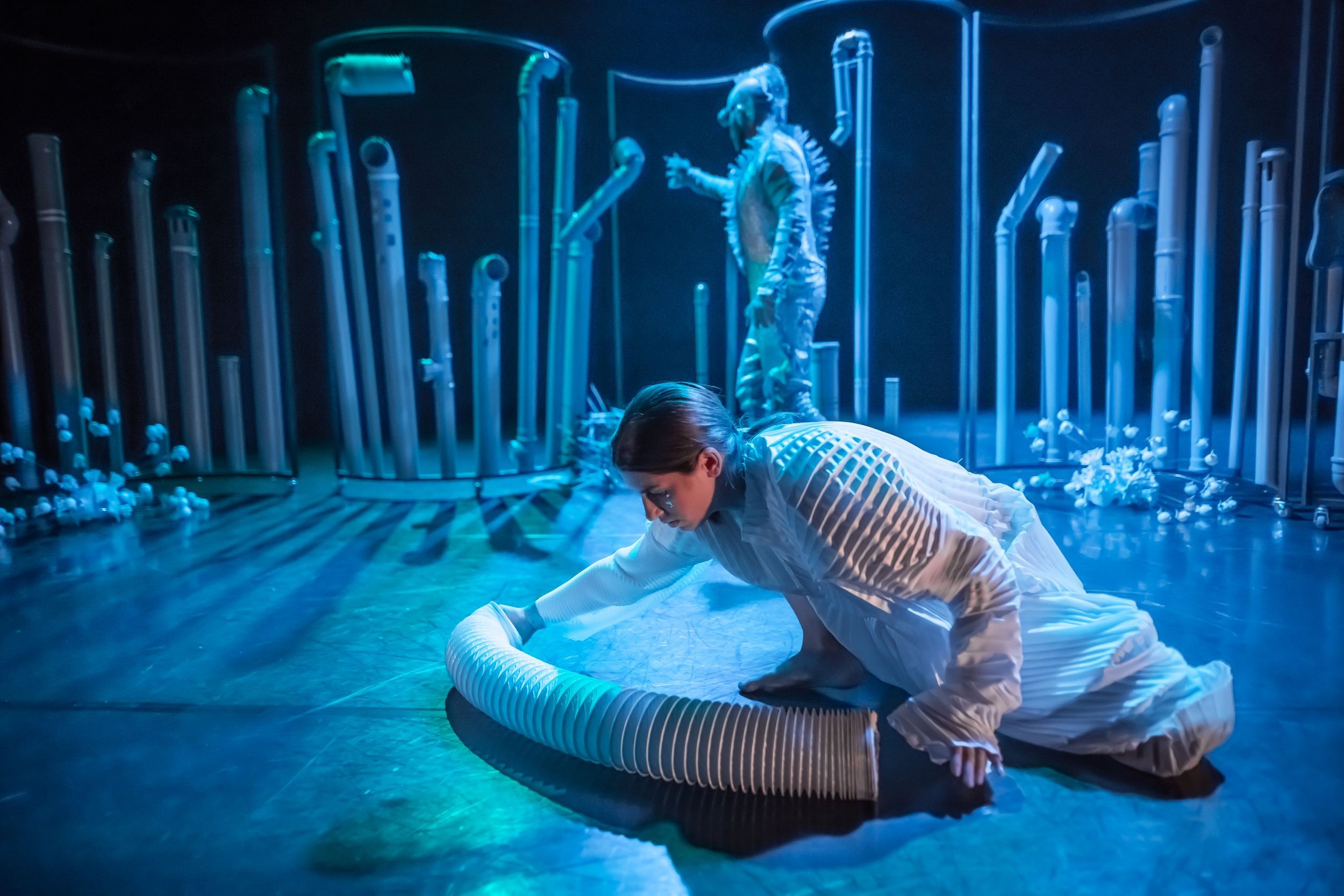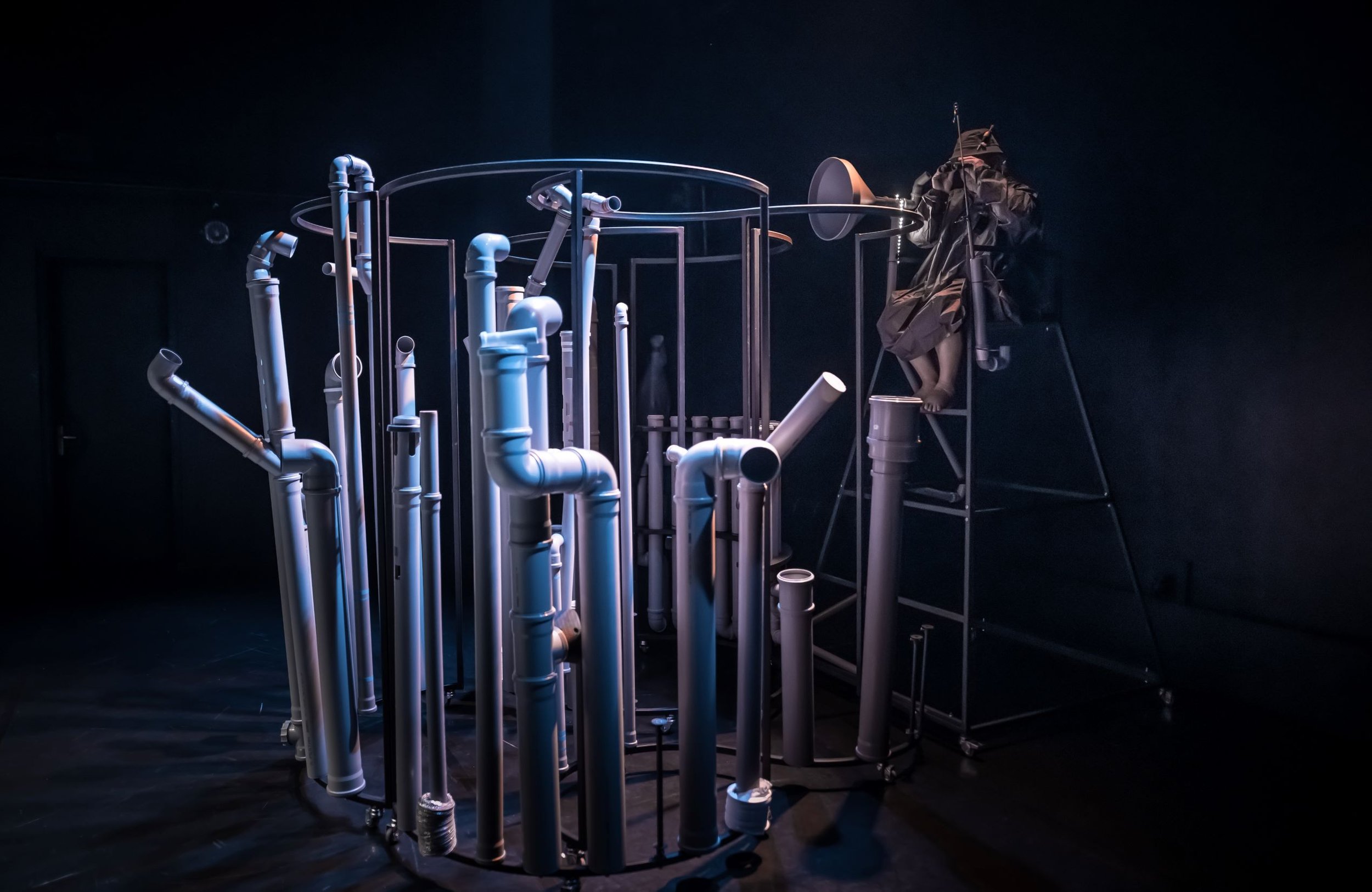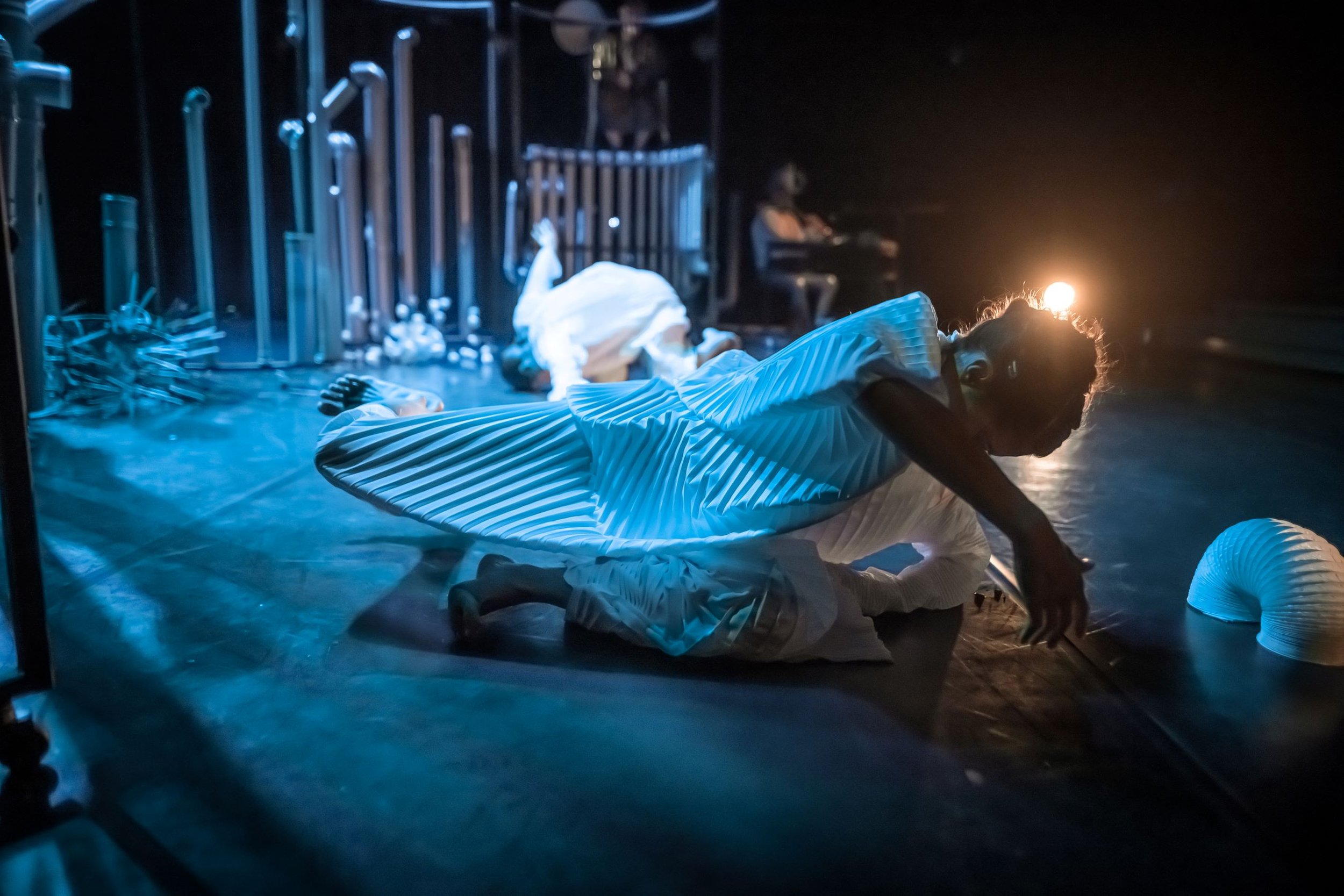Natalija Manojlović Varga, Andrej Rozman Roza
POVODNI MOŽ AMBROŽ / WATER MAN AMBROŽ
plesno-gledališka predstava za otroke 4+ / a dance-theatre performance for children 4+
Avtorstvo, koreografija in režija / Authored, Choreographed and Directed by: NATALIJA MANOJLOVIĆ VARGA
Soavtorstvo, avtor besedila in soustvarjanje / Co-authored, Written and Co-created by: ANDREJ ROZMAN ROZA
Avtorska glasba in izvedba / Original Music and Performance: BLAŽ CELAREC
Glasbenik na posnetku / Recorded Musician: JOŽI ŠALEJ
Soustvarjanje in izvedba / Co-created and Performed by: BARBARA KANC, KATARINA BARBARA KAVČIČ / VERONIKA VALDÉS, TINES ŠPIK, k.g. ANDREJ ROZMAN
Scenografija / Set Design: SARA SLIVNIK
Kostumografija / Costume Design: VASILIJA FIŠER
Oblikovanje svetlobe in tehnične rešitve / Lighting Design and Technical Solutions: JANKO OVEN
Izdelava kostumov / Costume make: VESNA NOVITOVIČ
Oblikovanje in izdelava mask / Masks Design and make: ALJA SUŠNIK, TINKA PRPAR
Asistentka scenografije / Assistant Scenographer: MARUŠA MALI
Kreativna producentka / Creative Producer: KATJA SOMRAK
Produkcija / Produced by: PLESNI TEATER LJUBLJANA
Zahvala / Thanks to: URŠA KODELA LAPAN
Program Plesnega Teatra Ljubljana sofinancirata Ministrstvo za kulturo RS in Mestna občina Ljubljana, Oddelek za kulturo / The programme of Plesni Teater Ljubljana is subsidized by the Ministry of Culture RS and Municipality of Ljubljana, Department for Culture
Foto / Photo: JAKA VARMUŽ
O predstavi
Ambrož živi v svetu, v katerem ni nobenih strojev, nobenih tovarn in nobenih trgovin. Vse, kar potrebuje, raste in plava v njegovem jezeru. Da mu ni preveč dolgčas, nagaja ribičem in se igra z vodnimi živalmi in predmeti, ki jih v njegovo jezero vržejo kopenski ljudje. Ko pa v jezero pade čevelj, ki je drugačen od tistega, ki že leži na dnu jezera, se Ambrož naenkrat spomni, da sta mu starša, preden sta ga zapustila in odšla v toplejše vode, naročila, da si mora nujno poiskat ženo, saj se sicer njihov rod ne bo nadaljeval. A kje naj jo najde? Povodnih ljudi je namreč veliko manj kot kopenskih in Ambrož ne pozna niti ene same povodne žene. Zato se odpravi na kopno, kjer pa je svet zelo drugačen. Tamkajšnji ljudje nosijo obleke, namesto vode pijejo čudne tekočine in počnejo Ambrožu povsem nerazumljive reči. Da se ga ne bi bali, se mora zavit v njihove obleke in se delat, da je eden od njih. A tudi tak se ne upa približati nobeni kopenski ženi. Dokler ga ena ne prosi, da bi ji odmašil odtok, skozi katerega spušča vso nesnago iz svoje hiše naravnost v reko. Ambrožu se to ne zdi prav, a če se ji hoče prikupit, mu ne ostane drugega, kot da ji pomaga. Ko pa se potopi v reko, da bi odmašil odtok, spozna nekoga, ki se z njegovo pomočjo pri zastrupljanju reke nikakor ne strinja.
About the performance
Ambrož lives in a world where there are no machines, no factories, and no shops. Everything he needs grows and floats in his lake. To pass the time, he annoys fishermen and plays with aquatic animals and objects thrown into his lake by land people. But when a shoe falls into the lake, which is different from the one already lying at the bottom of the lake, Ambrož suddenly remembers that his parents, before leaving him and moving to warmer waters, told him to find a wife to continue their family line. But where to look for her? There are far fewer water people than there are land people, and Ambrož does not know a single water woman. So he heads to the mainland, where the world is very different. The people there wear clothes, drink strange liquids instead of water, and do things that are completely incomprehensible to Ambrož. In order not to be afraid of him, he has to wrap himself in their clothes and pretend to be one of them. But even so, he does not dare to approach any land woman. Until one of them asks him to unclog her drain, through which she releases all the dirt from her house straight into the river. It doesn’t feel right to Ambrož, but if he wants to win her over, he has no choice but to help her. However, when he dives into the river to unclog the drain, he meets someone who doesn’t agree at all with his help in poisoning the river.
Izsek iz kritike
“Predstava Povodni mož Ambrož zabava in spodbuja otroško radovednost ter ustvarjalnost … Predstava kar dobro osvetli obstoječe stanje, da človek tega sveta ni ogrožen, ampak je sam tisti izvor nesnage in odpadkov, ki ogrožajo in uničujejo nedolžna življenja drugih prebivalcev mirnega in barvitega sveta na tej naši Zemlji. Že zarana je treba ozaveščati mladi rod o tej kruti resnici, kar se v dobro zastavljeni zgodbi o povodnem možu Ambrožu tudi primerno otrokom predstavi in odigra.” Daliborka Podboj, Parada plesa
“Plesno-gledališka uprizoritev temo povodnega moža izpiše povsem na novo, kot ljubezensko zgodbo z ekološko in družbeno noto. Osnovno dogajanje začrta z jedrnatim pripovedovanjem, odrski prostor pa odmeri predvsem bogastvu uprizoritvenih oblik in izoblikuje dinamično ter večplastno odrsko celoto, ki se odlikuje po gibalni, zvočni in vizualni igrivosti. Domiselna raba scenografskih elementov in zvočil ter pestrost impulzov in asociacij v koreografski ter vizualni podobi podpirajo ustvarjalno dojemanje umetniških izrazil, s katerimi uprizoritev zarisuje Ambroževo pot ter življenje in odnose v podvodnem ter kopenskem svetu – polno domišljije v poteku in z relevantnimi indici na problematične plati naše družbe.” Nika Arhar, Martina Peštaj in Adriana Gaberščik, mnenje strokovne komisije platforme Zlata Paličica
Excerpt from press review
“Water Man Ambrož entertains and encourages children's curiosity and creativity … The performance illuminates quite well the current state, in which humans of the world are not endangered, but are themselves a source of filth and waste that threaten and destroy innocent lives of other residents of the quiet and colourful world of our Earth. It is necessary to make the young generation aware of this harsh truth from an early age, and in the well-conceived story about Water Man Ambrož, this is presented and performed in a child friendly way.” Daliborka Podboj, Dance parade
“The dance-theatre performance rewrites the theme of the Water Man in a completely new manner, as a love story with an ecological and social note. It outlines the basic storyline with concise narration, and dedicates the stage primarily to the richness of staging forms, forming a dynamic and multi layered stage entirety characterised by playfulness in terms of movement, sound and visuality. The creative use of scenographic elements and sounds, accompanied by the diversity of impulses and associations in the choreographic and visual identity, support the creative perception of artistic expressions with which the performance depicts Water Man’s journey and life and relationships in the underwater and terrestrial world – full of imagination in motion and with relevant references to the problematic aspects of our society.“ Nika Arhar, Martina Peštaj and Adriana Gaberščik, expert committee of the Golden Stick platform





